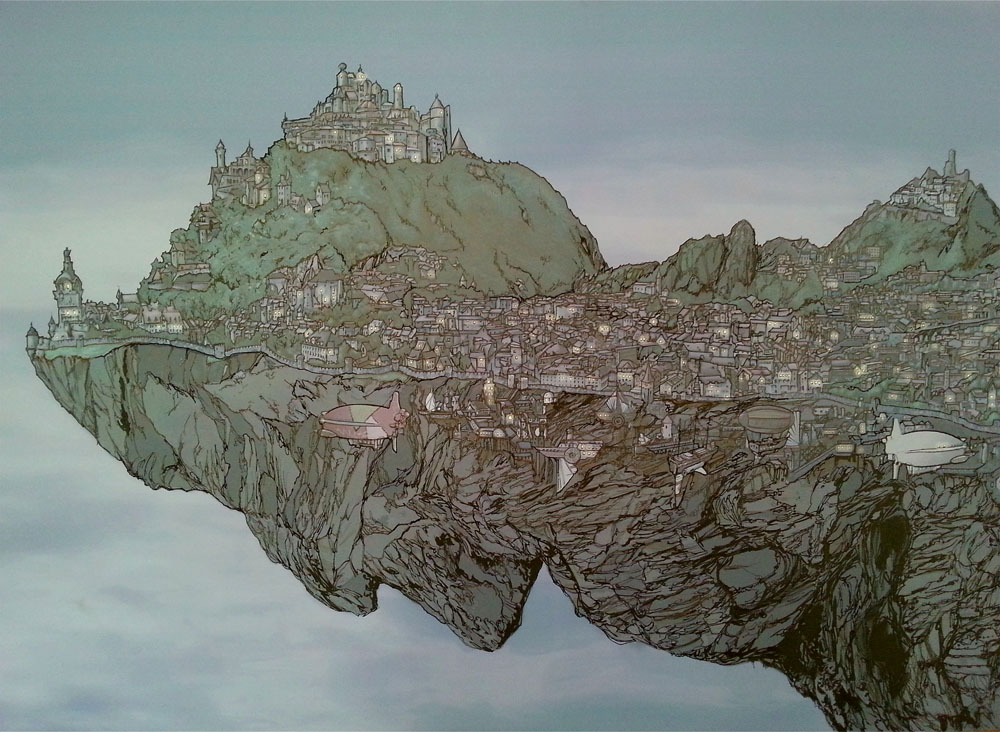In his spare time between writing his novel, composing music, playing in his band and creating otherworldly paintings and drawings, artistic mastermind Conrad Keely has taken to curating. On Wednesday January 28, Keely opened his latest exhibition at Show Box, The City, featuring works from a range of Phnom Penh-based artists, including himself, Peter Klashorst, David Holliday, Kosal Khiev and more.
While the title may seem relatively self-explanatory, this group show explores themes of the city on a multitude of levels, delving into the psychology of urbanity, exploring the reciprocal relationship between artistic design and functional architecture, and provoking questions of globalisation and sustainability.
Keely says that he was inspired by the idea of artists representing cities through art, as he believes “There’s a beauty in the ugly of cities.” He explains, “There’s something about the fact that we’ve created this thing that’s unnatural. Its function has nothing to do with art – it began completely through commerce. Tribal units had to trade with other cities, then we got agriculture and we had a reason to all be in one place. The beautification of the city grew out of the necessity to live together. So that aspect of urban space and architecture fascinates me. The psychology of urban spaces is something that really drew me to Phnom Penh rather than elsewhere.”
Keely insists that naming and basing the exhibition on a term that is in itself somewhat ambiguous was a key point of the show. Each artist was asked to express what “the city” meant to them through their own diverse and unbounded styles, as audiences are encouraged to question the obscurity of urbanity as a concept.
Keely describes his own perception of the theme as an ongoing social experiment. “As animals or tribal groups, we have this small radius of people with whom we interact, are related, and are our friends. But cities put us in this place where all these tribes, groups and families are just stuck together, often piled on top of each other. That’s kind of an experiment. Will this work long-term? How big do these cities get? We really don’t know.”
These notions are explored in his own exhibited work, which includes a watercolour of an imagined antebellum town, surrounded by the smog-filled haze of an ominously encroaching metropolis. Another is a concept design of a stacked bucolic city; an amalgamation of rural and urban contrasts. Alongside these, artist David Holliday presents a series of kaleidoscopic, highly saturated photo collages of Phnom Penh, while Peter Klashurst, a prolific and often controversial neo-expressionist artist, reflects his urban experience through an intimate portrait of a bargirl.
While the collection of artistic interpretations are incredibly diverse and ostensibly beautiful, their striking aesthetics belie a deeper, darker undercurrent that flows undeniably throughout the exhibition; a silent but ominous question mark over the future implications of Phnom Penh’s exponential expansion.
Keely, a self-declared optimist, points to sustainable development as the solution, and artists as the pioneers. “Sustainability is the future of urban spaces globally. It’s a new concept; cities were never supposed to be sustainable. They were supposed to consume, to come into a landscape and tame it. Now we’re having to redefine that. And I think it’s going to be artists who will be at the forefront of imagining what a sustainable city can be. Art often informs reality. If we want to imply how cities are going to look and what they’re going to become, we will need the vision of artists. I’ve seen future concept designs – map paintings for films and stuff. If that’s what we have to look forward to then it might not be that dystopian, post-apocalyptic Mad Max thing that’s often portrayed. It could actually be something of great beauty and wonder.”
WHO: Various local artists
WHAT: The City, group exhibition
WHEN: Now through February 10
WHERE: Show Box, #11 Street 330
WHY: Your future house may be showcased

Well put. I am a ceramic artist who loves abstracting the landscape. Nature is a no brainer–it’s amazing–it’s raw beauty. The city, however, is real. I hope sustainability is recognized by the powers that be– so far there is chaotic development and a concentrated materialistic craziness in cities.
Yet, as these artists convey, a beauty in the squares and rectangles, the dense textures of a megalopolis. I am with you on that. The landscape folds in and out. Nature grows. Man builds.